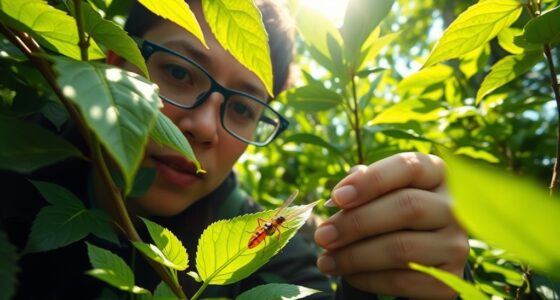Trees communicate through underground networks of fungi and aboveground signals, forming what’s called the “Wood Wide Web.” They share nutrients, warn each other of dangers, and support vulnerable saplings by transferring resources. Chemical signals, sound vibrations, and scent cues all play a part in this complex language. Understanding this helps reveal how forests stay resilient and connected. If you keep exploring, you’ll uncover even more fascinating ways trees talk and support each other.
Key Takeaways
- Trees communicate through underground mycorrhizal networks, sharing nutrients and signals across forest communities.
- Chemical signals, such as stress compounds and VOCs, alert neighboring trees to danger or environmental changes.
- Electrical signals and sound vibrations within trees trigger chemical responses and defense mechanisms.
- Mycorrhizal fungi connect roots, facilitating nutrient transfer and supporting vulnerable or young trees.
- Forest resilience is enhanced through interconnected networks that enable resource sharing and coordinated responses to threats.

Many people are surprised to learn that trees can communicate with each other, sharing information and resources through complex underground and aboveground networks. This remarkable ability relies on mycorrhizal networks—fungal hyphae that connect the roots of different trees, forming an intricate web commonly called the “Wood Wide Web.” Through this network, you can think of trees as social beings, exchanging nutrients like water and minerals to support each other’s survival. When one tree faces stress, such as drought or pest attack, it can send distress signals through these fungal pathways, alerting neighboring trees to prepare defenses or adjust their growth strategies.
The mechanisms behind tree communication are diverse and sophisticated. Mycorrhizal fungi establish symbiotic relationships with tree roots, creating a network that links multiple plants across a forest. Chemical signals, such as stress-induced compounds, travel through these fungal channels, conveying messages about environmental threats. Trees also communicate via airborne volatile organic compounds (VOCs); when attacked by insects, they release specific scents that neighboring trees can detect and respond to by boosting their defenses. Electrical signals generated within the trees themselves can also trigger chemical responses, while defensive chemicals and alluring scents act as part of their language, warning others or attracting predators of pests. Even sound vibrations and chemical cues are part of this complex communication system. This network is supported by the symbiotic fungi, which play a critical role in facilitating nutrient exchange and signaling.
These networks play a critical role in supporting the youngest and most vulnerable trees, especially saplings growing in shaded or resource-limited areas. The fungus-mediated web supplies essential nutrients, enabling these young plants to thrive despite challenging conditions. This nutrient transfer has been shown to significantly improve seedling survival rates in degraded or disturbed forests. in addition, the networks allow trees to recognize and support kin, fostering cooperation within families of trees that share genetic ties. This interconnectedness enhances the resilience of entire forest ecosystems. When environmental challenges arise, trees can coordinate their responses more effectively, sharing resources and warning each other of impending dangers like insect invasions or drought. As a result, the entire forest becomes more adaptable and robust.
Frequently Asked Questions
Can Trees Communicate With Animals or Humans?
You might wonder if trees can talk to animals or humans. While they don’t speak like us, trees send signals through chemical, electrical, and sound emissions. For example, stressed trees emit specific sounds or chemicals that animals can detect, influencing their behavior. Humans are just beginning to understand these signals, so it’s possible that, indirectly, trees communicate with animals, and maybe even with us, in ways we haven’t fully grasped yet.
Do Different Tree Species Have Distinct ‘Languages’?
You might find it fascinating that trees have their own subtle dialects, almost like unique languages. Each species uses different chemical signals tailored to their needs, allowing them to share warnings or resources. These signals vary widely, creating a complex web of communication. So, yes, trees do have their own distinct “languages,” which evolve based on their environment, relationships, and survival strategies, making the forest a truly intricate conversation.
How Do Trees Detect Environmental Changes Through Their Signals?
You might wonder how trees sense environmental changes. They generate electrophysiological signals that reflect their internal states when stimuli like drought, temperature, or light shift. Using sensors, you can record these signals continuously. Machine learning analyzes the data, recognizing patterns linked to specific conditions. These signals, combined with molecular and remote sensing data, give you a complete understanding of how trees detect and respond to their environment.
Are There Scientific Methods to Interpret Tree Communication?
You can interpret tree communication through various scientific methods. Chemical analysis helps identify signaling molecules like phenols and VOCs. Electrophysiology measures electrical signals within trees, revealing how they transmit information. DNA sequencing and fungal mapping uncover the structure of mycorrhizal networks that connect trees underground. Additionally, sensors and imaging detect responses to environmental cues, allowing you to understand how trees communicate and coordinate their responses within ecosystems.
Can Understanding Tree Language Help in Forest Conservation?
Imagine listening to a forest’s quiet whispers, where trees share essential warnings and nutrients through unseen networks. By understanding this tree language, you can better protect forests, ensuring these silent conversations remain undisturbed. This knowledge helps you conserve biodiversity, enhance natural defenses against pests, and foster healthier ecosystems. Embracing these signals allows you to manage forests more sustainably, respecting their intricate communication and supporting their resilience for future generations.
Conclusion
Now that you understand how trees communicate, you see their silent conversations all around you. You notice the whispers in the wind, the signals through roots, the messages in their growth. You realize that trees speak in signals, share in secrets, and connect in communities. With every breeze and every bark, you witness nature’s language unfolding. You listen, you learn, and you see—the language of trees is all around, waiting for you to understand.










